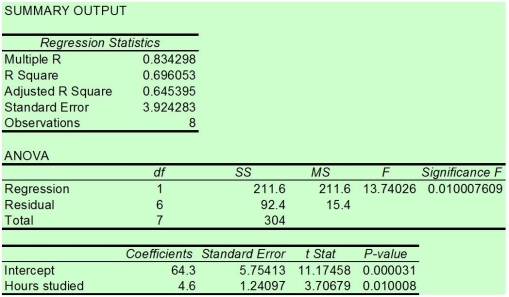THE NEXT QUESTIONS ARE BASED ON THE FOLLOWING INFORMATION:
A professor of statistics is interested in studying the relationship between the number of hours graduate students spent studying for his comprehensive final exam and the exam score.The results of the regression analysis of hours studied on exam scores are presented below. 
-Which of the following is true of the least squares equation,  = 20 + 5x?
= 20 + 5x?
Definitions:
Barriers To Entry
Elements that obstruct or impede the ability of businesses to penetrate a particular market or sector.
Elasticity Coefficient
The elasticity coefficient measures how much the quantity demanded or supplied of a good responds to a change in one of its determinants, such as price, income, or the price of related goods.
Perfectly Elastic
Describes a market situation where demand or supply can change infinitely with even the slightest change in price.
Demand Schedule
A table that shows the quantity of a good or service that consumers are willing and able to purchase at each price point.
Q4: What is the lower confidence limit of
Q14: Calculate an estimate of the common proportion.
Q43: You are interested in determining the factors
Q53: Find the upper confidence limit of the
Q54: The F test used for testing the
Q122: The multiple coefficient of determination for a
Q139: A multiple regression model involves 5 independent
Q143: When is the chi-square distribution test not
Q177: The regression sum of squares (SSR)can never
Q227: Compute the mean squares for regression.